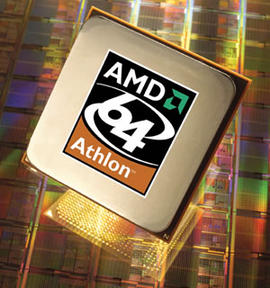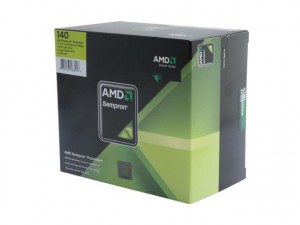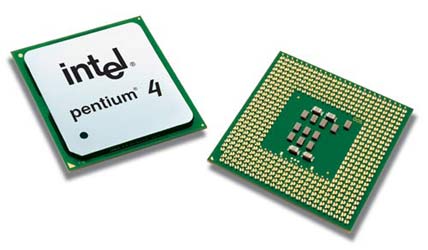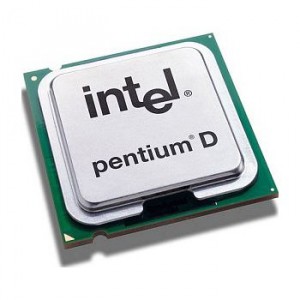A detailed history of the processor
Athlon 64, Athlon 64 X2 and Sempron (2003)
AMD’s Athlon 64 is the successor to the Athlon XP and is the second of AMD’s processors to to implement its own 64-bit architecture. The first processor to implement that 64-bit technology was the AMD Opteron, but that was targeted at commercial uses, such as servers and workstations. The Athlon 64, however, is the first 64-bit processor aimed at the consumer market. So, in a way, this is AMD’s first venture into 64-bit territory.
In the Athlon 64, AMD a second bus, the northbridge, to connect the CPU to the chipset and device attachment bus. AMD did this through a high-performance technology called HyperTransport (which boasted speeds of 800 MT/s to 1000 MT/s at the the time).
It’s worth noting that the Athlon 64 was only a single-core processor. However, AMD eventually launched an improved version of the Athlon 64, the Athlon 64 X2. This newer version launched in 2005 was the first dual-core desktop processor that was designed by AMD. In May of 2006, AMD released Athlon 64 X2 versions with AMD virtualization technology, commonly referred to as AMD-V.
Before that, AMD launched another processor called the Athlon 64 FX, which was intended towards hardware enthusiasts (like gamers). This is for a number of reasons, two of them being that its multipliers were always unlocked and that they always had the highest clock speeds of all the Athlons at launch. Eventually, AMD launched the Athlon 64 FX-60, which is when the Athlon 64 FX line went dual-core.
At the time of the Athlon 64’s launch, it was only available in Socket 754 and Socket 940. They introduced the Athlon 64 in Socket 754 largely because its onboard memory controller was incapable of running non-registered or unbuffered memory in dual-channel. Eventually, AMD launched the Athlon 64 on another socket — Socket 939. This was intended for the mainstream market with the dual-channel memory interface fix. This essentially replaces Socket 754, so Athlon 64s sold on Socket 754 were essentially moved to a budget line of processors.
AMD actually referred to its budget line of processors as Sempron, which was made out of a variety of different CPUs. The second generation of this line was loosely based on the Athlon 64 architecture, but earlier versions did not include the 64-bit technology, but also a reduced cache size. In the second half of 2005, AMD actually added the AMD64 support to the Sempron line in order to extend the market of 64-bit processors. This is because, at the time, 64-bit processors were a pretty niche market.
Pentium 4 Prescott, Celeron D and Pentium D (2005)
The Pentium 4 Prescott was introduced in 2004 to mixed feelings. The Pentium 4 Prescott was the first core to use the 90nm semiconductor manufacturing process. Many weren’t happy with it because the Prescott was essentially a restructuring of the Pentium 4’s microarchitecture. While that’d normally be a good thing, there weren’t too many positives. Some programs were enhanced by the doubled cache as well as the SSE3 instruction set. Unfortunately, there were other programs that suffered because of the longer instruction pipeline.
It’s also worth noting that the Pentum 4 Prescott was able to achieve some pretty high clock speeds, but not nearly as high as Intel was hoping. One version of the Prescott was actually able to obtain speeds of 3.8GHz. Eventually, Intel released a version of the Prescott supporting Intel’s 64-bit architecture, Intel 64. To start out, these were only sold as the F-series to OEMs, but Intel eventually renamed it to the 5×1 series, which was sold to consumers.
Intel introduced another version of the Prentium 4 Prescott, which was the Celeron D. A major difference with them is that they sported double the L1 and L2 cache than the previous Willamette and Northwood desktop Celerons. Not only that, but you got the SSE3 instruction set and they were manufactured on Socket 478. The Celeron D overall was a major performance improvement over many of the previous NetBurst-based Celerons. While there were major performance improvements across the board, it had a huge problem — excessive heat.
Eventually, Intel would go on to refresh the Celeron D, but this time with 64-bit architecture. Unfortunately, Intel never built these with Socket 478, but with the LGA 775 socket type.
Another one Intel made was the Pentium D. You can look at this processor as the dual-core variant of the Pentium 4 Prescott. You obviously get all the benefits that an extra core brings, but the other notable improvement with the Pentium D was that it could run multi-threaded applications. There were a few different generations of the Pentium D, all featuring small and minor improvements over the other, but the Pentium D series was eventually retired in 2008. The Pentium D had a lot of pitfalls, including high power consumption and that a single core of the Pentium D was built on two dies (more energy efficient CPUs and slower dual-core CPUs were on just a single die).
The true and overall better successor was the Intel Core 2 brand, which had a lot of success.
Click here: Next Page

























30 thoughts on “A detailed history of the processor”
In fact, the 8080 external interface was distinctly different from the 8086, in idea, not just width – for example, 8080 pin 21 (DMA acknowledge).
The 8086 was (almost) binary compatible with the 8080 for “regular programs” ie: not ones that twiddled ports nor relied on specific interrupt/trap behaviour.
So where do you draw the line? Where does Bob draw it? WHere does Fiona draw it? All in different places, I suspect.
The author obviously chose to draw their line at the 8086, probably because delving back beyond the original IBM PC machines might not be worthwhile given a presumed intended audience…
In fact, the 8080 external interface was distinctly different from the 8086, in idea, not just width – for example, 8080 pin 21 (DMA acknowledge).
The 8086 was (almost) binary compatible with the 8080 for “regular programs” ie: not ones that twiddled ports nor relied on specific interrupt/trap behaviour.
So where do you draw the line? Where does Bob draw it? WHere does Fiona draw it? All in different places, I suspect.
The author obviously chose to draw their line at the 8086, probably because delving back beyond the original IBM PC machines might not be worthwhile given a presumed intended audience…
In fact, the 8080 external interface was distinctly different from the 8086, in idea, not just width – for example, 8080 pin 21 (DMA acknowledge).
The 8086 was (almost) binary compatible with the 8080 for “regular programs” ie: not ones that twiddled ports nor relied on specific interrupt/trap behaviour.
So where do you draw the line? Where does Bob draw it? WHere does Fiona draw it? All in different places, I suspect.
The author obviously chose to draw their line at the 8086, probably because delving back beyond the original IBM PC machines might not be worthwhile given a presumed intended audience…
“The following chips are considered the dinosaurs of the computer world. PC’s based on these processors are the kind that usually sit around in the garage or warehouse collecting dust. They are not of much use anymore, but us geeks don’t like throwing them out because they still work. You know who you are.”
sounds just like my tech teacher becouse he is always complaining about how things have changed and shows us pictures from back when computers still used tapes and how he used to get paid to change the tapes every two hours for a hospitle
“The following chips are considered the dinosaurs of the computer world. PC’s based on these processors are the kind that usually sit around in the garage or warehouse collecting dust. They are not of much use anymore, but us geeks don’t like throwing them out because they still work. You know who you are.”
sounds just like my tech teacher becouse he is always complaining about how things have changed and shows us pictures from back when computers still used tapes and how he used to get paid to change the tapes every two hours for a hospitle
“The following chips are considered the dinosaurs of the computer world. PC’s based on these processors are the kind that usually sit around in the garage or warehouse collecting dust. They are not of much use anymore, but us geeks don’t like throwing them out because they still work. You know who you are.”
sounds just like my tech teacher becouse he is always complaining about how things have changed and shows us pictures from back when computers still used tapes and how he used to get paid to change the tapes every two hours for a hospitle